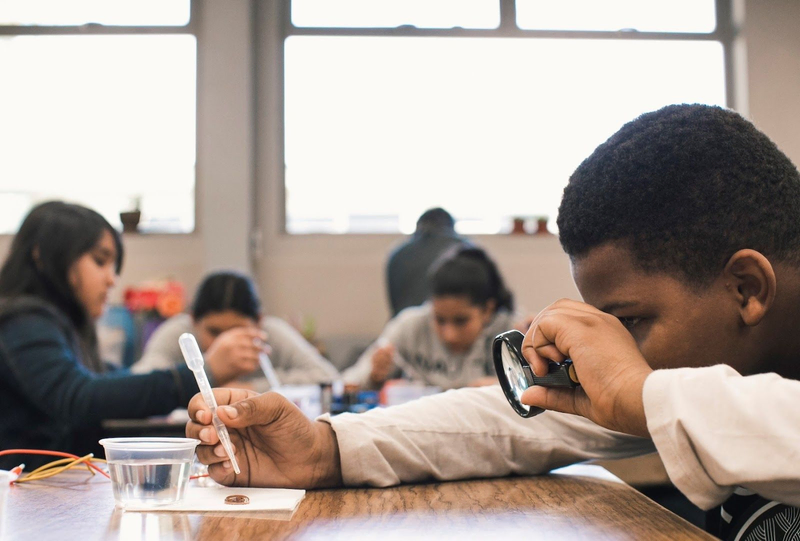With STEM (science, technology, engineering, math) careers expected to expand rapidly over the next decade, Santa Monica-Malibu Unified School District (SMMUSD) students have become prepped in the scientific realm with the help of a local organization.
This year, PS Science launched its middle school curriculum, providing materials to SMMUSD school sites and teachers for STEM lessons and using technology to do student-driven research. Lesson plans for middle schoolers also include learning about the importance of technological advances, as well as in-depth subjects like the gene modification process.
Starting in 2006, PS Science has been expanding its reach within the district, partnering with a multitude of sites like McKinley and Grant elementary schools, as well as the district’s middle schoolers.
The early access to science education is paramount, PS Science Board of Directors member and BLT Enterprises President Rob Solomon said. Solomon pointed to a recent skills assessment for PS Science students, which showed a 50-60% increase in students’ understanding of scientific ideas and testing, as compared to the national testing average for other students of the same age.
STEM is the natural evolution of the program, which currently serves 17 public schools in Los Angeles County and more than 12,000 students in total. The field is prime for career exploration, as the Bureau of Labor Statistics states that STEM careers are expected to grow at more than twice the rate of non-STEM careers over the next decade. The Department of Labor adds that total STEM occupations are expected to grow by almost 11% by 2031, with more lucrative salaries than non-STEM jobs.

“We are committed to getting much-needed STEM education in the hands of young children,” Solomon said. “We need to set our kids up for success early and ensure that all students have the same educational opportunities, no matter their socioeconomic background.”
PS Science Executive Director Julie Olds added that since science education is not as spotlighted as reading and math comprehension, due in large part to lack of state testing on the subject until 5th grade, out of school time has become an important part of the organization’s work. This includes offering assistance to after-school robotics programs in the STEM realm, while also offering summer camps to its TK-8 audience.
Olds, who has been with PS Science from the beginning, also said educators are curious if science testing scores appearing on the California School Dashboard going forward will “elevate” the concern over providing students requisite science education.
“From a societal perspective, we have a need for scientists and science education,” Solomon added. “It’s underfunded and underserved in California [at] the elementary school [level], and then that just continues on into middle school, so I think that the expansion of the [STEM] program through middle school will just help continue to get kids interested in science. We need, with a digital economy, more scientists.”
Getting kids interested means giving them substantial lessons while keeping things fun and interactive. Aligned with The Next Generation Science Standards, PS Science developed a curriculum for grades TK-8 that touch on Earth Science, Physical Science, Life Science and STEM. The nonprofit provides all lesson materials to teachers, as well as instructional videos on how to introduce a particular lesson to students.

One example Olds gave for younger grades was a lesson plan on different parts of plants, adding in units about the silkworm caterpillar’s relationship with the mulberry leaf, as well as the caterpillar’s metamorphosis into moths and their creation of silk, adding in how humans use the animal’s silk to produce products like fabrics.
From incorporating “living organisms” to working with artifacts, the director wanted to find ways to “expose the joy, awe and the discovery of the real world to kids.”
“Our number one kind of consideration when we were developing these lessons was, how do we make it as hands-on as possible, and how do we integrate as much stuff from the real world as possible … because we really feel like kids at this young age benefit from as much exposure as possible to what the real world is,” Olds said.
Students in 4th and 5th grade take part in a unit about Physical Science, looking at momentum, collisions and forces. The students build cars mostly out of paper, with an engineering challenge to protect an egg in a “car crash.” Activities such as that which promote problem-solving, Olds said, is “a really critical” skill set to attain.
“We want kids in most of the schools, if not all of them [to think] when our instructor comes to campus, or when their teacher says it’s science day, the kids are jumping up and down, like it’s the best day of the week,” Olds said. “It’s not the drudgery of memorization and testing.”
To learn more information about PS Science, or make a donation to the nonprofit, visit psscience.org.
thomas@smdp.com





